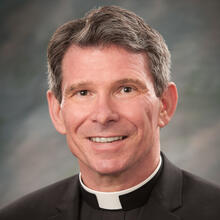There’s something similar to ourselves in a saint, something quite strange as well. We heed our own humanity in a holy one, but the familiar flows into the foreign. It’s as though in our encounter with the saint we glimpse two presences rather than one. The person we see and another, whom we cannot see, with whom the saint communes.
A woman we canonize this weekend, Kateri Tekakwitha, is a perfect example. Her own life could not have been more circumscribed, and yet, like the Saint Lawrence Waterway where she lived, two worlds met in her history. The waters of Christian Europe entered the dark woods of the North American continent. The familiar flowed into the foreign.
Even her name is a strange confluence of two worlds. Tekakwitha was her Mohawk name. Kateri is a mispronunciation of her European baptismal name, Catherine. Her 24 years of life, spent first in upstate New York and then outside Montreal, were marked by the confluence of two civilizations, European and Native American. Kateri’s parents died of small pox, the new disease the white peoples had brought with them. And, during her life, the saint’s face showed the marks of her own survival from the European illness.
Tekakwitha was her Mohawk name. Kateri is a mispronunciation of her European baptismal name, Catherine.
Sensing the presence of another within her, the Mohawk and Iroquois people with whom she lived began to revere her as a holy one even as she lay dying. Within only a few years, the Jesuits who had instructed her in the faith were urging others to pray to this dead Indian maiden for miracles, healings which indeed did come. Yet more than three hundred years have passed since her death in 1680 and her canonization this year. Why so much time? Perhaps because the life of this woman is so very different from our own. In this saint, the familiar flows deeply into the foreign.
The first challenge for moderns, trying to understand her, is the sheer monotony of her life in those dark woods. Her days were spent ceaselessly gathering firewood, often so heavy it required a head brace to port. She ground corn for meal by hand, by the hour, and sewed buckskin garments using animal sinews for thread. In addition to her pocked face and poor health, Kateri suffered from weak eye sight, the effect of a lifetime spent in smoke-filled long houses.
The two Jesuit fathers who knew her best, Claude Chauchetière and Pierre Cholenec, never really knew her. Though they struggled with Indian dialects, most of their catechesis was accomplished with gestures, pictures, and sacred objects. They certainly didn’t know, as it was happening, of Catherine’s predilection for forms of asceticism that strike us as extreme, even abhorrent. It was something she, and other young women of the settlement, kept hidden from them.
Kateri fasted from all food two days of week. She exposed her body to freezing temperatures, to fire and to repeated, bloody lashings. In declaring her a saint, what would the Church have us learn from her?
Kateri fasted from all food two days of week. She exposed her body to freezing temperatures, to fire and to repeated, bloody lashings. In declaring her a saint, what would the Church have us learn from her? What was in her mind? Her life was dark and full of suffering. Why chose to suffer more?
In his scholarly biography, Mohawk Saint: Catherine Tekekwitha and the Jesuits (2005), Allan Greer offers several explanations. Woodland Indians in Kateri’s time were often taken captive by rival tribes and then exposed to terrible tortures. Some Indians therefore regularly exposed themselves to pain as remote preparation for such an eventuality. Feminist scholars have suggested that asceticism, especially virginity, is a way for a woman to claim control of her own body and destiny, and Greer speculates that those who are weakest in society sometimes choose suffering as a way of exercising control over their fate. “Voluntarily inflicting pain on oneself is then part of the process of transvaluation by which suffering ceases to be pointless and random and becomes deeply meaningful to the sufferer” (121).
Like her Christ, Kateri took the apparently senseless suffering and death that is the lot of any human being and gave it meaning.
The Jesuits recorded some of Kateri’s last words, spoken to the women who nursed her. “Take courage, despise the words of those who have no faith.” “Be assured that you are pleasing in the sight of God and that I shall help you when I am with him.” “Never give up mortification.” How are we to understand her any better than we understand these troubling, perplexing words of Isaiah?
The Lord was pleased to crush him in infirmity. If he gives his life as an offering for sin, he shall see his descendants in a long life, and the will of the Lord shall be accomplished through him. Because of his affliction he shall see the light in fullness of days;?through his suffering, my servant shall justify many, and their guilt he shall bear. (53:10-11).
As Kateri prayed alone in the forest, why did her mysterious Beloved urge her to such extremes? But didn’t Kateri do what her own Lord had done? To mortify is to draw death (Latin: mors, mortis) into the self. Like her Christ, Kateri took the apparently senseless suffering and death that is the lot of any human being and gave it meaning. In mortification, she embraced death and made of it the gift of her own self. If death is the end, mortification makes little sense. If death is a passage, asceticism clears a path.
Death is the “undiscovered country.” Nothing is more foreign to us. And yet in the life of this virgin, in her intense love, the familiar flowed into the foreign. Death in life became a path to love.
Readings: Isaiah 53:10-11 Hebrews 4:14-16 Mark 10:35-45








